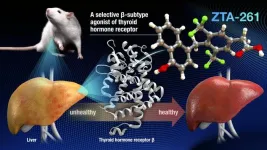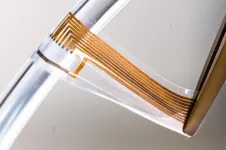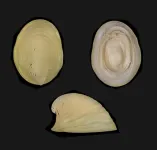(Press-News.org) In brief:
The chemical messenger orexin and the orexin neurons in the brain mediate the decision between exercise and snacking. Researchers at ETH Zurich made this discovery in mice. The results are likely to be transferable to humans.
In the experiment, mice with a blocked orexin system opted more frequently for the milkshake offered them and less for exercise.
These results could help in researching and developing new strategies to promote physical activity in people.
Should I go and exercise, or would I rather go to the café and enjoy a delectable strawberry milkshake? Until now, what exactly happens in our brain when we make this decision has been a mystery to science, but researchers at ETH Zurich have found the solution. They deciphered which brain chemical and which nerve cells mediate this decision: the messenger substance orexin and the neurons that produce it.
These neuroscientific fundamentals are relevant because many people don’t get enough exercise. Most of us have probably already decided once or even several times to skip exercising in favour of one of the numerous alternative temptations of daily life. According to the World Health Organization, 80 percent of adolescents and 27 percent of adults don’t get enough exercise. And obesity is increasing at an alarming rate not only among adults but also among children and adolescents.
Focus on orexin
“Despite these statistics, many people manage to resist the constantly present temptations and get enough exercise,” says Denis Burdakov, Professor of Neuroscience at ETH Zurich. “We wanted to know what it is in our brain that helps us make these decisions.”
In their experiments with mice, the researchers were able to show that orexin plays a key role in this process. It’s one of over a hundred messenger substances that are active in the brain. Other chemical messengers, such as serotonin and dopamine, were discovered a long time ago and their role has largely been decoded. The situation for orexin is different: researchers discovered it relatively late, around 25 years ago, and they are now clarifying its functions step by step. Burdakov is one of the scientists who have devoted their efforts to studying orexin.
Existing knowledge can’t explain the choice
“In neuroscience, dopamine is a popular explanation for why we choose to do some things but avoid others,” says Burdakov. This brain messenger is critical for our general motivation. “However, our current knowledge about dopamine does not easily explain why we decide to exercise instead of eating,” the scientist continues. “Our brain releases dopamine both when we eat and when we exercise, which does not explain why we choose one over the other.”
To find out what does, the researchers devised a sophisticated behavioural experiment for mice, which were able to choose freely from among eight different options in ten-minute trials. These included a wheel they could run on and a “milkshake bar” where they could enjoy a standard strawberry-flavoured milkshake. “Mice like a milkshake for the same reason people do: it contains lots of sugar and fat and tastes good,” says Burdakov.
Less time at the milkshake bar
In their experiment, the scientists compared different groups of mice: one made up of normal mice and one in which the mice’s orexin systems were blocked, either with a drug or through genetic modification of their cells.
The mice with an intact orexin system spent twice as much time on the running wheel and half as much time at the milkshake bar as the mice whose orexin system had been blocked. Interestingly, however, the behaviour of the two groups didn’t differ in experiments in which the scientists only offered the mice either the running wheel or the milkshake. “This means that the primary role of the orexin system is not to control how much the mice move or how much they eat,” Burdakov says. “Rather, it seems central to making the decision between one and the other, when both options are available.” Without orexin, the decision was strongly in favour of the milkshake, and the mice gave up exercising in favour of eating.
Helping people who do little exercise
The ETH Zurich researchers expect that orexin may also be responsible for this decision in humans; the brain functions involved here are known to be practically the same in both species. “It will now be a matter of verifying our results in humans”, says Daria Peleg-Raibstein, group leader at ETH Zurich. She led the study together with Denis Burdakov. This could involve examining patients who have a restricted orexin system for genetic reasons – this is the case in around one in two thousand people. These people suffer from narcolepsy (a sleeping disorder). Another possibility would be to observe people who receive a drug that blocks orexin. Such drugs are authorised for patients with insomnia.
“If we understand how the brain arbitrates between food consumption and physical activity, we can develop more effective strategies for addressing the global obesity epidemic and related metabolic disorders,” says Peleg-Raibstein. In particular, interventions could be developed to help overcome exercise barriers in healthy individuals and those whose physical activity is limited. However, Burdakov points out that these would be important questions for scientists involved in clinical research in humans. He and his group have dedicated themselves to basic neuroscientific research. Next he wants to find out how the orexin neurons interact with the rest of the brain when making decisions like the one between exercise and snacking.
END
Sport or snack? How our brain decides
Countless temptations can stop us from exercising.
2024-08-06
ELSE PRESS RELEASES FROM THIS DATE:
A new way of thinking about the economy could help protect the Amazon, and help its people thrive
2024-08-06
To protect the Amazon and support the wellbeing of its people, its economy needs to shift from environmentally harmful production to a model built around the diversity of indigenous and rural communities, and standing forests.
A group of conservationists from Bolivia, Brazil, Peru, Ecuador, the US and the UK say that current conservation and development efforts will never sustain or scale without systemic changes in how economies are designed.
Despite extensive destruction of the Amazon in the name of economic development, Amazonian communities have seen little improvement in income, life expectancy, and education. The researchers have ...
Controlling lipid levels with less side effects possible with new drug
2024-08-06
Scientists at Nagoya University in Japan have made a significant breakthrough in treating lipid disorders. They have developed a new compound, ZTA-261, which selectively binds to the thyroid hormone receptor beta (THRβ). THRβ plays an important role in the regulation of lipid metabolism, which affects lipid levels in the blood. Mice administered the drug showed decreased lipid levels in the liver and blood, with fewer side effects in the liver, heart, and bones compared to existing compounds. These findings, published in Communications Medicine, suggest that ZTA-261 ...
Research spotlight: Analyzing the effectiveness of heart therapies and outcomes for patients with chip
2024-08-06
Nicholas A. Marston, MD, MPH, of the TIMI Study Group and Carl J. and Ruth Shapiro Cardiovascular Center at Brigham and Women’s Hospital, is the corresponding author of a paper published in Nature Medicine, “Clonal hematopoiesis, cardiovascular events and treatment benefit in 63,700 individuals from five TIMI randomized trials.”
How would you summarize your study for a lay audience?
Clonal hematopoiesis of indeterminate potential (CHIP) is a condition that promotes the multiplication of blood stem cells in the body and increases the ...
Soft gold enables connections between nerves and electronics
2024-08-06
Gold does not readily lend itself to being turned into long, thin threads. But researchers at Linköping University in Sweden have now managed to create gold nanowires and develop soft electrodes that can be connected to the nervous system. The electrodes are soft as nerves, stretchable and electrically conductive, and are projected to last for a long time in the body.
Some people have a “heart of gold”, so why not “nerves of gold”? In the future, it may be possible to use this precious metal in soft interfaces to connect electronics to the nervous system for medical ...
The race to discover biodiversity: 11 new marine species and a new platform for rapid species description
2024-08-06
Accelerating global change continues to threaten Earth’s vast biodiversity, including in the oceans, which remain largely unexplored. To date, only a small fraction of an estimated two million total living marine species have been named and described. A major challenge is the time it takes to scientifically describe and publish a new species, which is a crucial step in studying and protecting these species. The current scientific and publishing landscape often results in decade-long delays (20-40 years) from the discovery of a new species to its official description. As an ...
18th Annual Q-Bio Conference: Global scholars explore new Frontiers in quantitative biology
2024-08-06
The 18th Q-Bio Conference on Quantitative Biology was held at the Guangming Yungu International Conference Center in Shenzhen from July 26 to 29, 2024. Organized by the Shenzhen Institute of Advanced Technology (SIAT) of the Chinese Academy of Sciences (CAS), the Shenzhen Institute of Synthetic Biology (iSynBio), and Peking University, the conference drew over 230 global researchers from countries including the U.S., U.K., France, India, Japan, Chile, and China.
Themed "Predictive Modeling and Quantitative Principles in Complex Biological Systems," the event explored future prospects in quantitative and synthetic biology. Under ...
Eating more fruits & vegetables to reduce dietary acid lowers blood pressure and improves kidney and heart health in patients with hypertension
2024-08-06
Philadelphia, August 6, 2024 – Doctors recommend making fruits and vegetables a foundational part of the treatment of patients with hypertension. Diets high in fruits and vegetables are found to lower blood pressure, reduce cardiovascular risk, and improve kidney health due to their base-producing effects. A new study in The American Journal of Medicine, published by Elsevier, details the findings from a five-year interventional randomized control trial.
Despite ongoing efforts to improve hypertension treatment and reduce its adverse outcomes with pharmacological strategies, hypertension-related chronic kidney disease and its cardiovascular mortality are increasing. Heart disease ...
Rising toll of serious injuries linked to expanded Mexico-US border wall crossing
2024-08-06
The expansion of the Mexico-US border wall crossing has been accompanied by a rising toll of serious injuries, with poor discharge care and a lack of appropriate interpreting facilities adding up to a “humanitarian and health crisis,” suggest researchers in the open access journal Trauma Surgery & Acute Care Open.
Thirty eight different nationalities and 21 languages other than Spanish were represented among those attempting to cross one segment of the wall in 2021 and 2022, say the researchers.
The Mexico-US border wall was extended by 50 miles and raised to a height of 30 feet in Southern California, construction ...
Interplay of sex, marital status, education, race linked to 18 year US lifespan gap
2024-08-06
The interplay of a quartet of sex, marital status, education, and race is linked to an 18 year lifespan gap for US citizens, and while no one factor is more influential than any of the others, the more of these influential factors a person has, the higher their risk of an earlier death, finds research published in the open access journal BMJ Open.
But a simple scoring system based on these characteristics can help overcome this complexity to identify those most at risk, say the researchers.
Individual risks and genetic factors explain part of the differences in health and death, but the evidence increasingly points to the role of social determinants—the ...
Arizona State University research site designated UNESCO World Heritage Site
2024-08-05
At the edge of the south coast of South Africa, Arizona State University professor Curtis Marean and his research teams have been teasing out the secrets of our earliest modern human ancestors in caves at Pinnacle Point for over 25 years.
In late July, the site was declared a UNESCO World Heritage Site, the Olympic gold medal of heritage, which is only given to sites of “outstanding universal value” to all of humanity.
In 1999, while conducting reconnaissance on the south coast ...
LAST 30 PRESS RELEASES:
First Editorial of 2026: Resisting AI slop
Joint ground- and space-based observations reveal Saturn-mass rogue planet
Inheritable genetic variant offers protection against blood cancer risk and progression
Pigs settled Pacific islands alongside early human voyagers
A Coral reef’s daily pulse reshapes microbes in surrounding waters
EAST Tokamak experiments exceed plasma density limit, offering new approach to fusion ignition
Groundbreaking discovery reveals Africa’s oldest cremation pyre and complex ritual practices
First breathing ‘lung-on-chip’ developed using genetically identical cells
How people moved pigs across the Pacific
Interaction of climate change and human activity and its impact on plant diversity in Qinghai-Tibet plateau
From addressing uncertainty to national strategy: an interpretation of Professor Lim Siong Guan’s views
Clinical trials on AI language model use in digestive healthcare
Scientists improve robotic visual–inertial trajectory localization accuracy using cross-modal interaction and selection techniques
Correlation between cancer cachexia and immune-related adverse events in HCC
Human adipose tissue: a new source for functional organoids
Metro lines double as freight highways during off-peak hours, Beijing study shows
Biomedical functions and applications of nanomaterials in tumor diagnosis and treatment: perspectives from ophthalmic oncology
3D imaging unveils how passivation improves perovskite solar cell performance
Enriching framework Al sites in 8-membered rings of Cu-SSZ-39 zeolite to enhance low-temperature ammonia selective catalytic reduction performance
AI-powered RNA drug development: a new frontier in therapeutics
Decoupling the HOR enhancement on PtRu: Dynamically matching interfacial water to reaction coordinates
Sulfur isn’t poisonous when it synergistically acts with phosphine in olefins hydroformylation
URI researchers uncover molecular mechanisms behind speciation in corals
Chitin based carbon aerogel offers a cleaner way to store thermal energy
Tracing hidden sources of nitrate pollution in rapidly changing rural urban landscapes
Viruses on plastic pollution may quietly accelerate the spread of antibiotic resistance
Three UH Rainbow Babies & Children’s faculty elected to prestigious American Pediatric Society
Tunnel resilience models unveiled to aid post-earthquake recovery
Satellite communication systems: the future of 5G/6G connectivity
Space computing power networks: a new frontier for satellite technologies
[Press-News.org] Sport or snack? How our brain decidesCountless temptations can stop us from exercising.




